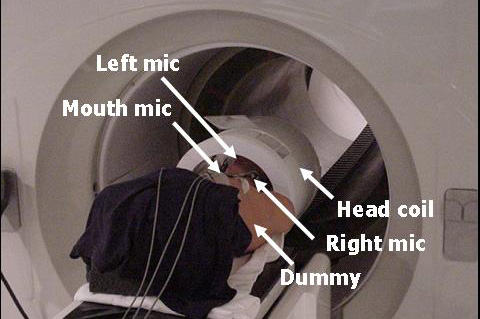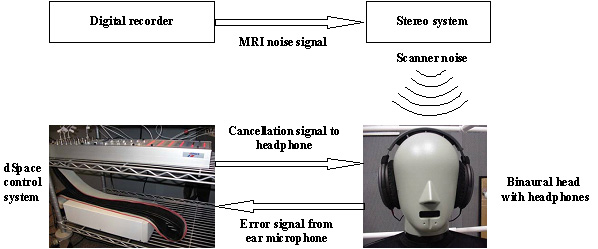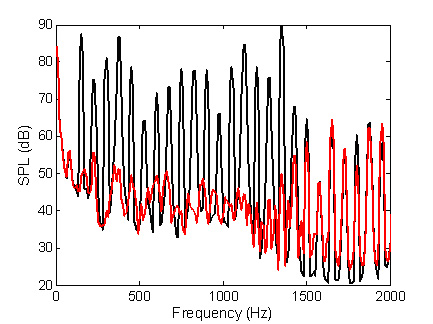Active Noise Control of Magnetic Resonance Imaging Scanner Using
Inverse Modeling Technique
Mingfeng Li -
limf@ucmail.uc.edu
Teik C.
Lim - teik.lim@uc.edu
Department
of Mechanical Engineering
Jing-Huei Lee - leej8@ucmail.uc.edu
Center for
Imaging Research
Department
of Biomedical Engineering
Popular version of paper 1aNCc2
Presented Monday morning, April 19, 2010
159th ASA Meeting,
Magnetic resonance imaging (MRI) is a very important medical diagnostic imaging system for providing valuable information for patients. During the scanning process, magnetic field gradients are rapidly pulsed to achieve fast imaging by quickly alternating electrical current to the gradient coils. This fast-switching electrical current in the main static field produces strong Lorentz forces that physically agitate the structural components of the MRI scanner, effectively turning the gradient coil system into a loudspeaker (i.e. through the structural-acoustic coupling with the surrounding air). The generated high sound pressure levels can be annoying and potentially unsafe to patients and healthcare workers, especially during lengthy procedures. Sound pressure levels in excess of 115 dB on a 3 Tesla MRI scanner have been report. Our test results show as much as 120 dB from a 4 Tesla MRI scanner. This level of noise can cause permanent hearing damage if unprotected. The US Food and Drug Administration (FDA) and the Occupational Safety and Health Administration (OSHA) limit the daily noise dosage of a person to the equivalent of 90 dBA (A-weighted decibels) for 8 hours in setting exposure threshold in MRI procedures. Hence, wearing ear protection is mandatory for patients and care workers near the scanner.
Traditional approaches to reduceingMRI noise include modifying gradient coil design, changing the system resonances of the coil assembly, using sound absorbing materials, designing silent MRI pulse sequence and wearing passive ear-protection devices. However, these methods are only effective to a limited extent. For low frequency noise, the passive materials and structures must be bulky and massive, which are not appropriate for the MRI application. In general, frequencies above 1 kHz may be adequately attenuated by 30 dB using ear protection, but lower frequencies around 250 Hz are only attenuated up to 10 dB, which is not sufficient for MRI noise.
Active noise control offers an alternative solution to this problem by introducing an anti-phase acoustic wave to create a zone of destructive interference at a particular area in space. With the rapid development of digital signal processing, including hardware as well as software algorithms, this technique has drawn increased attention and has been utilized in many acoustic noise problems where a traditional passive approach is not suitable or efficient.
Active noise control systems are typically based on two major approaches, namely feedback control and feedforward control. Normally, both of them will include a speaker to generate an anti-phase acoustic wave, a microphone for error measurements of the response at the target location (typically the ear), digital signal processing board, etc. For the feedforward control system, an additional microphone or sensor is required to provide a reference signal for the control algorithm. Our previous studies used multiple reference signals in the system. This will make the system more complex and costly. In this research, an active headset with integrated microphone and speaker components was applied in conjunction with inverse modeling technique to suppress simulated MRI acoustic noise using response data acquired from a 4T research scanner. The proposed control system used the internal model control (IMC) method which required only one error sensor.
To save controller development cost
and testing time, a physical simulation environment is created in a sound
quality chamber. The chamber is quiet and equipped with high fidelity audio
equipment and a binaural head system. MRI noise is pre-recorded using a high
precision digital recorder during an actual MRI scan at the UC College of
Medicines Center for Imaging Research. In Figure 1, a 4-Tesla Varian MRI
scanner (

Figure 1. A 4-Tesla MRI scanner used in the study
To create the response of MRI noise
mimicking actual scanning, the recorded sound from the MRI scanner was played
back through high fidelity audio equipment to reproduce the MRI noise
environment at the patient head. The headset used to reproduce the cancellation
sound is a commercially available MRI compatible set containing piezoceramic speakers
from Resonance Technology (

Figure 2. Lab experimental setup of MRI noise control
The MRI noise used for the physical simulation here is a typical MRI scanning sequence, i.e. Gradient Echo MultiSlice (GEMS) Sequence. The frequency spectrum measured at the patients ear before (black line) and after (red line) control is shown in Figure 3. It is clearly shown that the response of the MRI noise is reduced significantly when the controller is activated. The effective frequency range is up to 1.5 kHz. The maximum reduction is approximately 40 dB. The overall reduction is about 20 dB for the entire audible spectrum.

Figure 3. Experimental results of proposed control system
As discussed above, a physical simulation of a 4-T MRI scanner was created by replaying prerecorded sound through a high fidelity stereo system in a sound quality chamber. An MRI compatible active control headset was successfully used in this simulated environment to suppress the MRI noise. In this study, the active controller was designed using an inverse modeling technique and internal model control arrangement. Hence, the cost of the controller was minimized by using only one error microphone in the system. The computational burden of the algorithm was also reduced since only a simple least means square (LMS) algorithm is implemented in the system, not the more complex filtered-x LMS algorithm. The result shows that an overall reduction of almost 20 dB can be achieved. Further research to refine the control system to extend the effective frequency range to a higher frequency is underway.